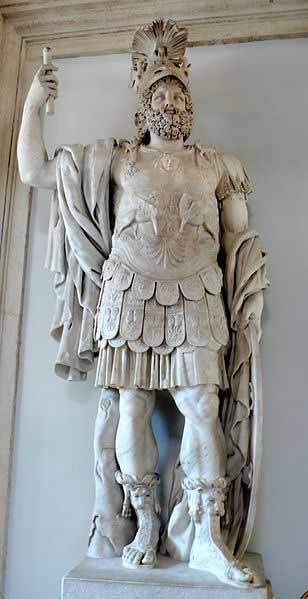

In ancient Roman religion and myth, Mars was the god of war and also an agricultural guardian, a combination characteristic of early Rome. He was second in importance only to Jupiter and he was the most prominent of the military gods in the religion of the Roman army. Most of his festivals were held in March, the month named for him (Latin Martius), and in October, which began the season for military campaigning and ended the season for farming.
Under the influence of Greek culture, Mars was identified with the Greek god Ares, whose myths were reinterpreted in Roman literature and art under the name of Mars. But the character and dignity of Mars differed in fundamental ways from that of his Greek counterpart, who is often treated with contempt and revulsion in Greek literature. Mars was a part of the Archaic Triad along with Jupiter and Quirinus, the latter of whom, as a guardian of the Roman people, had no Greek equivalent. Mars' altar in the Campus Martius, the area of Rome that took its name from him, was supposed to have been dedicated by Numa, the peace-loving semi-legendary second king of Rome. Although the center of Mars' worship was originally located outside the sacred boundary of Rome (pomerium), Augustus made the god a renewed focus of Roman religion by establishing the Temple of Mars Ultor in his new forum.
Although Ares was viewed primarily as a destructive and destabilizing force, Mars represented military power as a way to secure peace, and was a father (pater) of the Roman people. In the mythic genealogy and founding myths of Rome, Mars was the father of Romulus and Remus with Rhea Silvia. His love affair with Venus symbolically reconciled the two different traditions of Rome's founding; Venus was the divine mother of the hero Aeneas, celebrated as the Trojan refugee who "founded" Rome several generations before Romulus laid out the city walls.
The importance of Mars in establishing religious and cultural identity within the Roman Empire is indicated by the vast number of inscriptions identifying him with a local deity, particularly in the Western provinces.
Like Ares who was the son of Zeus and Hera, Mars is usually considered to be the son of Jupiter and Juno. However, in a version of his birth given by Ovid, he was the son of Juno alone. Jupiter had usurped the mother's function when he gave birth to Minerva directly from his forehead (or mind); to restore the balance, Juno sought the advice of the goddess Flora on how to do the same. Flora obtained a magic flower (Latin flos, plural flores, a masculine word) and tested it on a heifer who became fecund at once. She then plucked a flower ritually using her thumb, touched Juno's belly, and impregnated her. Juno withdrew to Thrace and the shore of Marmara for the birth.
Ovid tells this story in the Fasti, his long-form poetic work on the Roman calendar. It may explain why the Matronalia, a festival celebrated by married women in honor of Juno as a goddess of childbirth, occurred on the first day of Mars' month, which is also marked on a calendar from late antiquity as the birthday of Mars. In the earliest Roman calendar, March was the first month, and the god would have been born with the new year. Ovid is the only source for the story. He may be presenting a literary myth of his own invention, or an otherwise unknown archaic Italic tradition; either way, in choosing to include the story, he emphasizes that Mars was connected to plant life and was not alienated from female nurture.
The consort of Mars was Nerio or Neriene, "Valor." She represents the vital force (vis), power (potentia) and majesty (maiestas) of Mars. Her name was regarded as Sabine in origin and is equivalent to Latin virtus, "manly virtue" (from vir, "man").
In the early 3rd century BCE, the comic playwright Plautus has a reference to Mars greeting Nerio, his wife. A source from late antiquity says that Mars and Neriene were celebrated together at a festival held on March 23.
In the later Roman Empire, Neriene came to be identified with Minerva.
Nerio probably originates as a divine personification of Mars' power, as such abstractions in Latin are generally feminine. Her name appears with that of Mars in an archaic prayer invoking a series of abstract qualities, each paired with the name of a deity. The influence of Greek mythology and its anthropomorphic gods may have caused Roman writers to treat these pairs as "marriages.
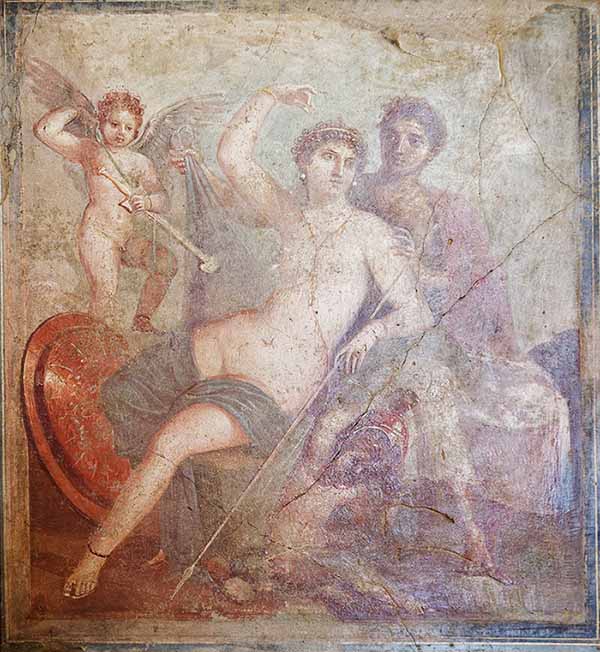
The union of Venus and Mars held greater appeal for poets and philosophers, and the couple were a frequent subject of art. In Greek myth, the adultery of Ares and Aphrodite had been exposed to ridicule when her husband Hephaestus (whose Roman equivalent was Vulcan) caught them in the act by means of a magical snare. Although not originally part of the Roman tradition, in 217 BCE Venus and Mars were presented as a complementary pair in the lectisternium, a public banquet at which images of twelve major gods of the Roman state were presented on couches as if present and participating.
Scenes of Venus and Mars in Roman art often ignore the adulterous implications of their union, and take pleasure in the good-looking couple attended by Cupid or multiple Loves (amores). Some scenes may imply marriage, and the relationship was romanticized in funerary or domestic art in which husbands and wives had themselves portrayed as the passionate divine couple.
The uniting of deities representing Love and War lent itself to allegory, especially since the lovers were the parents of Concordia.[citation needed] The Renaissance philosopher Marsilio Ficino notes that "only Venus dominates Mars, and he never dominates her".
In ancient Roman and Renaissance art, Mars is often shown disarmed and relaxed, or even sleeping, but the extramarital nature of their affair can also suggest that this peace is impermanent.
A relief depicting Mars and Venus on a black-slip bowl from Campania, Italy, 250Ð150 BCE, British Museum
Virility as a kind of life force (vis) or virtue (virtus) is an essential characteristic of Mars. As an agricultural guardian, he directs his energies toward creating conditions that allow crops to grow, which may include warding off hostile forces of nature.
The priesthood of the Arval Brothers called on Mars to drive off "rust" (lues), with its double meaning of wheat fungus and the red oxides that affect metal, a threat to both iron farm implements and weaponry. In the surviving text of their hymn, the Arval Brothers invoked Mars as ferus, "savage" or "feral" like a wild animal.
Mars' potential for savagery is expressed in his obscure connections to the wild woodlands, and he may even have originated as a god of the wild, beyond the boundaries set by humans, and thus a force to be propitiated. In his book on farming, Cato invokes Mars Silvanus for a ritual to be carried out in silva, in the woods, an uncultivated place that if not held within bounds can threaten to overtake the fields needed for crops. Mars' character as an agricultural god may derive solely from his role as a defender and protector, or may be inseparable from his warrior nature, as the leaping of his armed priests the Salii was meant to quicken the growth of crops.
It appears that Mars was originally a thunderer or storm deity, which explains some of his mixed traits in regards to fertility. This role was later taken in the Roman pantheon by several other gods, such as Summanus or Jupiter.
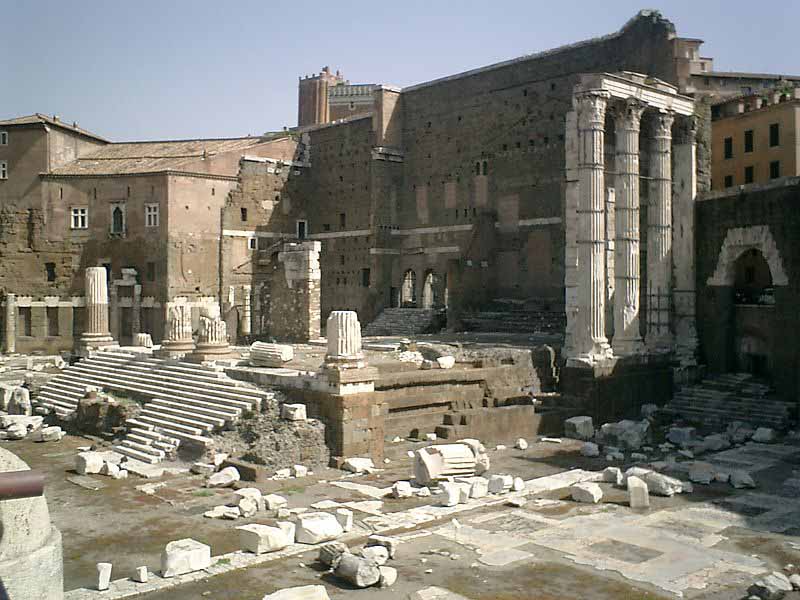
The earliest center in Rome for cultivating Mars as a deity was the Altar of Mars (Ara Martis) in the Campus Martius ("Field of Mars") outside the sacred boundary of Rome (pomerium). The Romans thought that this altar had been established by the semi-legendary Numa Pompilius, the peace-loving successor of Romulus.
According to Roman tradition, the Campus Martius had been consecrated to Mars by their ancestors to serve as horse pasturage and an equestrian training ground for youths. During the Roman Republic (509Ð27 BCE), the Campus was a largely open expanse.
No temple was built at the altar, but from 193 BCE a covered walkway connected it to the Porta Fontinalis, near the office and archives of the Roman censors. Newly elected censors placed their curule chairs by the altar, and when they had finished conducting the census, the citizens were collectively purified with a suovetaurilia there.
A frieze from the so-called "Altar" of Domitius Ahenobarbus is thought to depict the census, and may show Mars himself standing by the altar as the procession of victims advances.
The main Temple of Mars (Aedes Martis) in the Republican period also lay outside the sacred boundary and was devoted to the god's warrior aspect.[64] It was built to fulfill a vow (votum) made by a Titus Quinctius in 388 BCE during the Gallic siege of Rome. The founding day (dies natalis) was commemorated on June 1, and the temple is attested by several inscriptions and literary sources. The sculpture group of Mars and the wolves was displayed there. Soldiers sometimes assembled at the temple before heading off to war, and it was the point of departure for a major parade of Roman cavalry held annually on July 15.
A temple to Mars in the Circus Flaminius was built around 133 BCE, funded by Decimus Junius Brutus Callaicus from war booty. It housed a colossal statue of Mars and a nude Venus.
The Campus Martius continued to provide venues for equestrian events such as chariot racing during the Imperial period, but under the first emperor Augustus it underwent a major program of urban renewal, marked by monumental architecture. The Altar of Augustan Peace (Ara Pacis Augustae) was located there, as was the Obelisk of Montecitorio, imported from Egypt to form the pointer (gnomon) of the Solarium Augusti, a giant sundial. With its public gardens, the Campus became one of the most attractive places in the city to visit.
Augustus chose the Campus Martius as the site of his new Temple to Mars Ultor, a manifestation of Mars he cultivated as the avenger (ultor) of the murder of Julius Caesar and of the military disaster suffered at the Battle of Carrhae. When the legionary standards lost to the Parthians were recovered, they were housed in the new temple. The date of the temple's dedication on May 12 was aligned with the heliacal setting of the constellation Scorpio, the sign of war.The date continued to be marked with circus games as late as the mid-4th century AD.
A large statue of Mars was part of the short-lived Arch of Nero, which was built in 62 CE but dismantled after Nero's suicide and disgrace (damnatio memoriae).
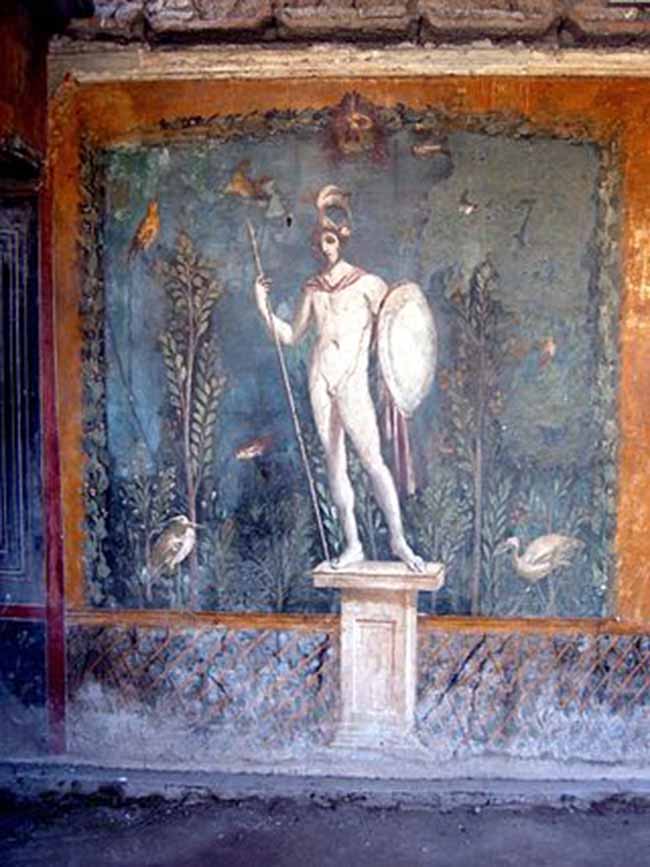
In Roman art, Mars is depicted as either bearded and mature, or young and clean-shaven. Even nude or seminude, he often wears a helmet or carries a spear as emblems of his warrior nature. Mars was among the deities to appear on the earliest Roman coinage in the late 4th and early 3rd century BCE.
On the Altar of Peace (Ara Pacis), built in the last years of the 1st century BCE, Mars is a mature man with a "handsome, classicizing" face, and a short curly beard and moustache. His helmet is a plumed neo-Attic-type. He wears a military cloak (paludamentum) and a cuirass ornamented with a gorgoneion. Although the relief is somewhat damaged at this spot, he appears to hold a spear garlanded in laurel, symbolizing a peace that is won by military victory.
The 1st-century statue of Mars found in the Forum of Nerva (pictured at top) is similar. In this guise, Mars is presented as the dignified ancestor of the Roman people. The panel of the Ara Pacis on which he appears would have faced the Campus Martius, reminding viewers that Mars was the god whose altar Numa established there, that is, the god of Rome's oldest civic and military institutions.
Particularly in works of art influenced by the Greek tradition, Mars may be portrayed in a manner that resembles Ares, youthful, beardless, and often nude.In the Renaissance, Mars' nudity was thought to represent his lack of fear in facing danger.

The high priest of Mars in Roman public religion was the Flamen Martialis, who was one of the three major priests in the fifteen-member college of flamens. Mars was also served by the Salii, a twelve-member priesthood of patrician youths who dressed as archaic warriors and danced in procession around the city in March. Both priesthoods extend to the earliest periods of Roman history, and patrician birth was required. Read more

MARS - ASTRONOMY
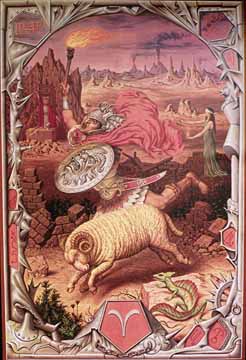
MARS - ASTROLOGY
ANCIENT AND LOST CIVILIZATIONS